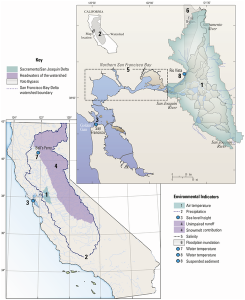If you think California’s water problems look bad now, just wait.
That seems to be the message of a new study by a team from the USGS, Scripps, Berkeley and elsewhere who ran detailed simulations of climate change scenarios on the Sacramento-San Joaquin Delta/San Francisco Bay system.
The project provides a useful exercise, not in prediction, but rather in sketching out possible scenarios that give a feel for the envelope of uncertainty decision-makers face going forward:
We emphasize that such model-based projections are not predictions but instead are plausible depictions of how this complex landscape might respond to prescribed model- and emissions-specific future climates.
Using a couple of different model runs, with varying greenhouse gas emission trajectories, the scientists found:
- warming temperatures
- reduced runoff
- rising sea level
- rising salinity
One of the key findings is that not all climate change trajectories look alike – both because of uncertainty in the models themselves (in the so-called “sensitivity” to rising greenhouse gases) and, more importantly, in the irreducible uncertainty of greenhouse gas trajectories. The latter is the biggest problem. One might hope that science will reduce the uncertainty in the models, but or inability to predict future human economic and societal development means we’ll always have an irreducible level of cluelessness about future greenhouse gas emissions trajectories. If both models agree on a key feature, policy makers can be more confident they’ll have to deal with it. In areas where the models highlight fundamental uncertainties, policies need to be robust to the possibilities of different outcomes:
This classification of projected responses to climate change suggests that regional planners and resource managers should consider: (a) strategies for adaptation to progressively increasing air and water temperature, sea level and salinity intrusion in the SFEW, and further shifts toward more runoff in winter and less in spring-summer; but (b) planning for a broad range of future water supply because GCMs differ widely in their projections of precipitation trends. Effective strategies will be flexible and responsive to new data and assessments of climate change as they emerge.
Given the current situation, this stuff is worth serious consideration:
California’s water supply (annual unimpaired runoff) is projected to decline or remain steady (Fig. 3), and demands are likely to increase as populations and temperatures rise. Deficits of surface runoff are now met with groundwater pumping. However, pumping between 1998 and 2010 depleted 48.5 km3 of water from the Central Valley groundwater system, and continued groundwater depletion at this rate is unsustainable [66]. Future strategies of water management will require adaptations such as aggressively increasing water-use efficiency, reducing surface water deliveries, capturing more runoff in surface storage or groundwater recharge, and implementing programs of integrated regional water management [67]. Model results suggest that the inherent large annual variability of precipitation will persist (Fig. 2), even as longer-term trends of warming and possibly drying take hold. Therefore, water-resource planning should also include contingencies for longer dry seasons, extended droughts, and extreme floods due to shifts from snow to rain. Diminishing snow packs result in earlier reservoir inflow, so reservoir operations must adapt to a shift toward more water being managed as a hazard (flood control) and less as a resource (reservoir storage). Additional freshwater releases to mitigate increased salinity intrusion into the estuary will be required to maintain quality of drinking water to communities that use the Delta as their municipal water supply. These adaptations to maintain water supply for human consumptive uses will potentially constrain availability of water to meet objectives of habitat conservation plans, such as restoring natural flow and salinity variability to promote recovery of native biota in the Delta [13].


An “inability to predict future human economic and societal development means we’ll always have an irreducible level of cluelessness about future greenhouse gas emissions trajectories”?
Except that we can run the model projections based on the current emissions path. IMHO that should always be done with studies like this one. That way those who object to the results have the burden of demonstrating why future emissions are likely to vary. Of course it should be adequate to take the approach of more-or-less bracketing the future (as these authors did), but is that too subtle for policymakers?
Unfortunately, it doesn’t seem to have really been a bracketing since emissions reality is tracking beyond even the more pessimistic of the scenarios the researchers used.
Since the IPCC doesn’t have a central scenario, maybe researchers can use the IEA reference scenario instead.
Somewhat off topic, somewhat old, but something on your beat